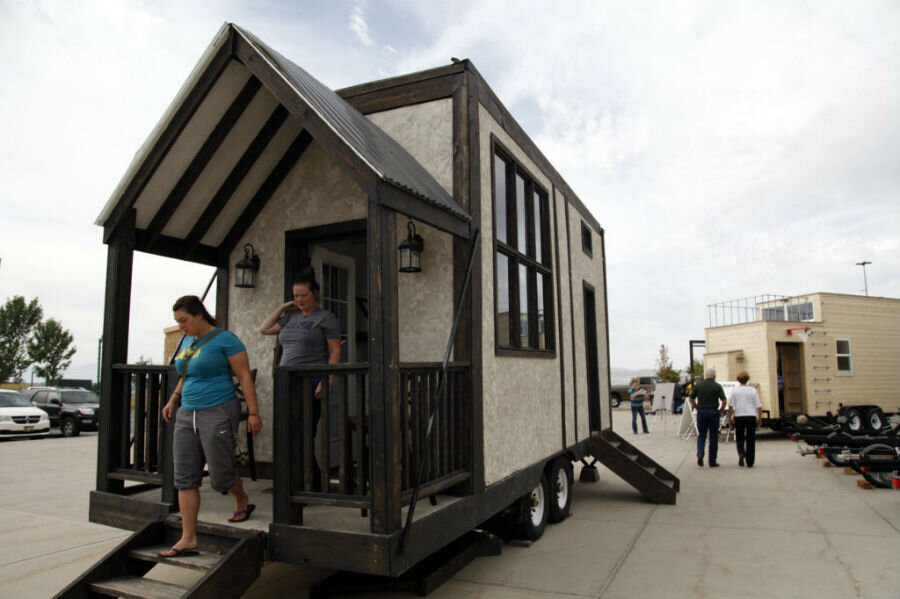Tiny town: Detroit agency aims to bring city's homeless out of the cold
Loading...
Sometimes, a tiny solution can go a long way toward fixing a big problem.
Tiny houses have become a fad in the United States. These homes, which have only a fraction of the square footage of traditional houses, are cheap to build, easy to maintain, and energy efficient. But as tiny houses catch on among more affluent members of the population, many have realized the potential of such buildings as a means to help the less fortunate as well.
Detroit is the latest city to build a community of tiny houses to provide homeless and low-income people with affordable housing. The new community will also be the first in the US to give residents the chance a rent-to-own these houses as a way to both provide for their basic needs as well as helping them achieve their own financial independence.
The creation of the community in Detroit is led by Cass Community Services, which runs various shelters and provides food and medical care to poverty-stricken people across the embattled city. The tiny house program is its most recent effort to help impoverished Detroit residents, with the first housing applications having been accepted earlier this month.
"This is a program about aspirations," the Rev. Faith Fowler, the executive director of Cass, said during a news conference, according to the Detroit Free Press. "This isn’t just a housing program. This program is ready for people who are ready [to become homeowners]."
Estimates of the numbers of homeless people living in the US vary widely, but one count taken during one night in January 2015 found 564,708 people without a home nationwide, according to the National Alliance to End Homelessness.
A number of tiny house communities have sprouted in recent years as an affordable housing solution for low-income people, as Christian Science Monitor correspondent Husna Haq reported in January:
The tiny house movement began in Downtown LA in the mid-1990s with Dome Village, a cluster of geodesic domes. It received national attention in 2001, when activists protested the treatment of homeless people in Portland by erecting a tent city. The tent city was eventually relocated and replaced with tiny houses. Dubbed Dignity Village, the collection of micro homes helped give rise to the idea of a tiny-house village for the homeless. Today, these villages offer small structures in which residents can sleep and find privacy, and larger communal buildings with bathrooms, kitchens, and recreational space.
The appeal for tiny houses for low-income individuals is the low cost of living. Since tiny houses are 500 square feet and smaller, they don't cost much to heat and are cheaper to rent than the average home with more than 2,500 square feet of space. In winter, monthly heating bills for a mid-size 300-square-foot home in this community is expected to cost about $32 a month, according to Curbed Detroit. Rent for the houses will not exceed a third of most residents' monthly income.
"Everybody is talking right now about ending homelessness, but really the goal for this project is to end poverty for these families," Rev. Fowler told Business Insider.
Tiny house communities will not be able to solve the problem of homelessness by themselves, however. In many places, tiny houses are actually illegal, due to a combination of legal confusion about how to identify the structures, worries that they will drive down traditional property values, and complications associated with connecting them to utilities. Even in places that do allow tiny houses, they are often relegated to communities farther away from traditional housing, which tends to alienate the population and make transportation to jobs and shopping difficult. While this may be a selling point for some tiny house enthusiasts, it is not a desirable goal for the recently homeless and those living in poverty.
"The other communities we visited are outside of town, they’re removed from the life of the city," Fowler told Business Insider. "We wanted to tuck ours into an existing neighborhood."
The new tiny houses are expected to benefit the extant Detroit neighborhood as well, which had been full of empty lots before the land was taken over by Cass.
"What it does is provide affordable housing for people who can’t afford something else on their own," Jim Vella, the president of Ford Motor Company Fund, which donated $400,000 to the project, told the Detroit Free Press. "So as the city looks at what it has to do to make neighborhoods viable again, this isn’t the option for every neighborhood, but it could work."
The first seven houses are expected to be built by the end of the year. Each of the eventual 25 houses in the community will be unique, providing shelter and dignity for each resident, Fowler told Business Insider.
"You have something to leave on generationally in your family, which is part of the American Dream," she said.








